Yi-Ting Chen
Toward Real-world BEV Perception: Depth Uncertainty Estimation via Gaussian Splatting
Apr 03, 2025Abstract:Bird's-eye view (BEV) perception has gained significant attention because it provides a unified representation to fuse multiple view images and enables a wide range of down-stream autonomous driving tasks, such as forecasting and planning. Recent state-of-the-art models utilize projection-based methods which formulate BEV perception as query learning to bypass explicit depth estimation. While we observe promising advancements in this paradigm, they still fall short of real-world applications because of the lack of uncertainty modeling and expensive computational requirement. In this work, we introduce GaussianLSS, a novel uncertainty-aware BEV perception framework that revisits unprojection-based methods, specifically the Lift-Splat-Shoot (LSS) paradigm, and enhances them with depth un-certainty modeling. GaussianLSS represents spatial dispersion by learning a soft depth mean and computing the variance of the depth distribution, which implicitly captures object extents. We then transform the depth distribution into 3D Gaussians and rasterize them to construct uncertainty-aware BEV features. We evaluate GaussianLSS on the nuScenes dataset, achieving state-of-the-art performance compared to unprojection-based methods. In particular, it provides significant advantages in speed, running 2.5x faster, and in memory efficiency, using 0.3x less memory compared to projection-based methods, while achieving competitive performance with only a 0.4% IoU difference.
What Changed and What Could Have Changed? State-Change Counterfactuals for Procedure-Aware Video Representation Learning
Mar 27, 2025Abstract:Understanding a procedural activity requires modeling both how action steps transform the scene, and how evolving scene transformations can influence the sequence of action steps, even those that are accidental or erroneous. Existing work has studied procedure-aware video representations by proposing novel approaches such as modeling the temporal order of actions and has not explicitly learned the state changes (scene transformations). In this work, we study procedure-aware video representation learning by incorporating state-change descriptions generated by Large Language Models (LLMs) as supervision signals for video encoders. Moreover, we generate state-change counterfactuals that simulate hypothesized failure outcomes, allowing models to learn by imagining the unseen ``What if'' scenarios. This counterfactual reasoning facilitates the model's ability to understand the cause and effect of each step in an activity. To verify the procedure awareness of our model, we conduct extensive experiments on procedure-aware tasks, including temporal action segmentation and error detection. Our results demonstrate the effectiveness of the proposed state-change descriptions and their counterfactuals and achieve significant improvements on multiple tasks. We will make our source code and data publicly available soon.
ATARS: An Aerial Traffic Atomic Activity Recognition and Temporal Segmentation Dataset
Mar 24, 2025Abstract:Traffic Atomic Activity which describes traffic patterns for topological intersection dynamics is a crucial topic for the advancement of intelligent driving systems. However, existing atomic activity datasets are collected from an egocentric view, which cannot support the scenarios where traffic activities in an entire intersection are required. Moreover, existing datasets only provide video-level atomic activity annotations, which require exhausting efforts to manually trim the videos for recognition and limit their applications to untrimmed videos. To bridge this gap, we introduce the Aerial Traffic Atomic Activity Recognition and Segmentation (ATARS) dataset, the first aerial dataset designed for multi-label atomic activity analysis. We offer atomic activity labels for each frame, which accurately record the intervals for traffic activities. Moreover, we propose a novel task, Multi-label Temporal Atomic Activity Recognition, enabling the study of accurate temporal localization for atomic activity and easing the burden of manual video trimming for recognition. We conduct extensive experiments to evaluate existing state-of-the-art models on both atomic activity recognition and temporal atomic activity segmentation. The results highlight the unique challenges of our ATARS dataset, such as recognizing extremely small objects' activities. We further provide comprehensive discussion analyzing these challenges and offer valuable insights for future direction to improve recognizing atomic activity in aerial view. Our source code and dataset are available at https://github.com/magecliff96/ATARS/
Mitigating Cross-Modal Distraction and Ensuring Geometric Feasibility via Affordance-Guided, Self-Consistent MLLMs for Food Preparation Task Planning
Mar 17, 2025Abstract:We study Multimodal Large Language Models (MLLMs) with in-context learning for food preparation task planning. In this context, we identify two key challenges: cross-modal distraction and geometric feasibility. Cross-modal distraction occurs when the inclusion of visual input degrades the reasoning performance of a MLLM. Geometric feasibility refers to the ability of MLLMs to ensure that the selected skills are physically executable in the environment. To address these issues, we adapt Chain of Thought (CoT) with Self-Consistency to mitigate reasoning loss from cross-modal distractions and use affordance predictor as skill preconditions to guide MLLM on geometric feasibility. We construct a dataset to evaluate the ability of MLLMs on quantity estimation, reachability analysis, relative positioning and collision avoidance. We conducted a detailed evaluation to identify issues among different baselines and analyze the reasons for improvement, providing insights into each approach. Our method reaches a success rate of 76.7% on the entire dataset, showing a substantial improvement over the CoT baseline at 36.7%.
ArticuBot: Learning Universal Articulated Object Manipulation Policy via Large Scale Simulation
Mar 04, 2025Abstract:This paper presents ArticuBot, in which a single learned policy enables a robotics system to open diverse categories of unseen articulated objects in the real world. This task has long been challenging for robotics due to the large variations in the geometry, size, and articulation types of such objects. Our system, Articubot, consists of three parts: generating a large number of demonstrations in physics-based simulation, distilling all generated demonstrations into a point cloud-based neural policy via imitation learning, and performing zero-shot sim2real transfer to real robotics systems. Utilizing sampling-based grasping and motion planning, our demonstration generalization pipeline is fast and effective, generating a total of 42.3k demonstrations over 322 training articulated objects. For policy learning, we propose a novel hierarchical policy representation, in which the high-level policy learns the sub-goal for the end-effector, and the low-level policy learns how to move the end-effector conditioned on the predicted goal. We demonstrate that this hierarchical approach achieves much better object-level generalization compared to the non-hierarchical version. We further propose a novel weighted displacement model for the high-level policy that grounds the prediction into the existing 3D structure of the scene, outperforming alternative policy representations. We show that our learned policy can zero-shot transfer to three different real robot settings: a fixed table-top Franka arm across two different labs, and an X-Arm on a mobile base, opening multiple unseen articulated objects across two labs, real lounges, and kitchens. Videos and code can be found on our project website: https://articubot.github.io/.
Potential Field as Scene Affordance for Behavior Change-Based Visual Risk Object Identification
Sep 24, 2024



Abstract:We study behavior change-based visual risk object identification (Visual-ROI), a critical framework designed to detect potential hazards for intelligent driving systems. Existing methods often show significant limitations in spatial accuracy and temporal consistency, stemming from an incomplete understanding of scene affordance. For example, these methods frequently misidentify vehicles that do not impact the ego vehicle as risk objects. Furthermore, existing behavior change-based methods are inefficient because they implement causal inference in the perspective image space. We propose a new framework with a Bird's Eye View (BEV) representation to overcome the above challenges. Specifically, we utilize potential fields as scene affordance, involving repulsive forces derived from road infrastructure and traffic participants, along with attractive forces sourced from target destinations. In this work, we compute potential fields by assigning different energy levels according to the semantic labels obtained from BEV semantic segmentation. We conduct thorough experiments and ablation studies, comparing the proposed method with various state-of-the-art algorithms on both synthetic and real-world datasets. Our results show a notable increase in spatial and temporal consistency, with enhancements of 20.3% and 11.6% on the RiskBench dataset, respectively. Additionally, we can improve computational efficiency by 88%. We achieve improvements of 5.4% in spatial accuracy and 7.2% in temporal consistency on the nuScenes dataset.
Shared-unique Features and Task-aware Prioritized Sampling on Multi-task Reinforcement Learning
Jun 02, 2024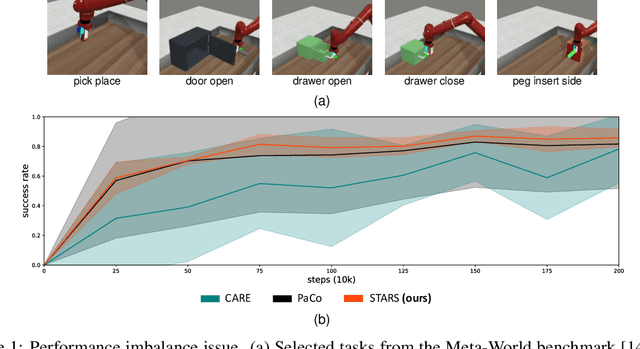
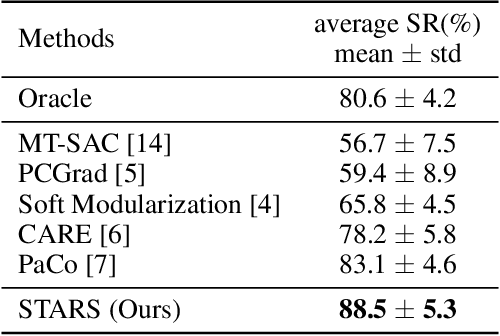
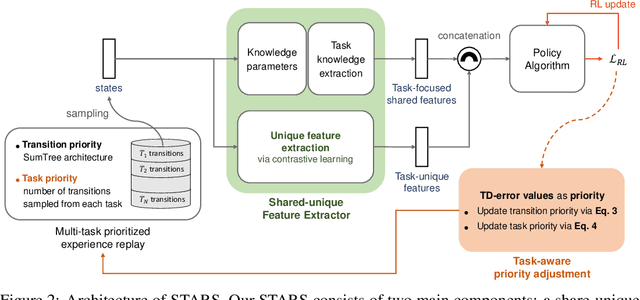

Abstract:We observe that current state-of-the-art (SOTA) methods suffer from the performance imbalance issue when performing multi-task reinforcement learning (MTRL) tasks. While these methods may achieve impressive performance on average, they perform extremely poorly on a few tasks. To address this, we propose a new and effective method called STARS, which consists of two novel strategies: a shared-unique feature extractor and task-aware prioritized sampling. First, the shared-unique feature extractor learns both shared and task-specific features to enable better synergy of knowledge between different tasks. Second, the task-aware sampling strategy is combined with the prioritized experience replay for efficient learning on tasks with poor performance. The effectiveness and stability of our STARS are verified through experiments on the mainstream Meta-World benchmark. From the results, our STARS statistically outperforms current SOTA methods and alleviates the performance imbalance issue. Besides, we visualize the learned features to support our claims and enhance the interpretability of STARS.
VividDream: Generating 3D Scene with Ambient Dynamics
May 30, 2024Abstract:We introduce VividDream, a method for generating explorable 4D scenes with ambient dynamics from a single input image or text prompt. VividDream first expands an input image into a static 3D point cloud through iterative inpainting and geometry merging. An ensemble of animated videos is then generated using video diffusion models with quality refinement techniques and conditioned on renderings of the static 3D scene from the sampled camera trajectories. We then optimize a canonical 4D scene representation using an animated video ensemble, with per-video motion embeddings and visibility masks to mitigate inconsistencies. The resulting 4D scene enables free-view exploration of a 3D scene with plausible ambient scene dynamics. Experiments demonstrate that VividDream can provide human viewers with compelling 4D experiences generated based on diverse real images and text prompts.
VICtoR: Learning Hierarchical Vision-Instruction Correlation Rewards for Long-horizon Manipulation
May 26, 2024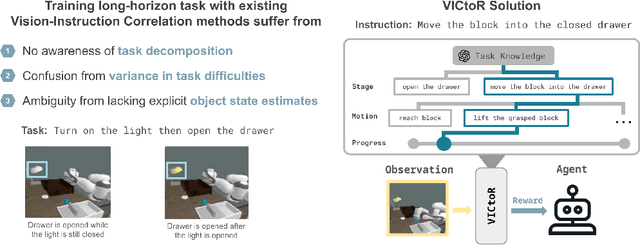
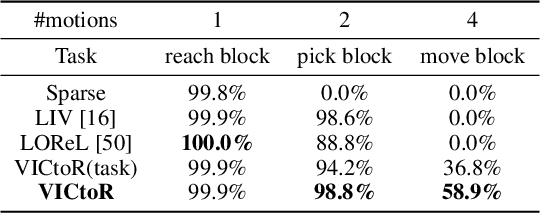
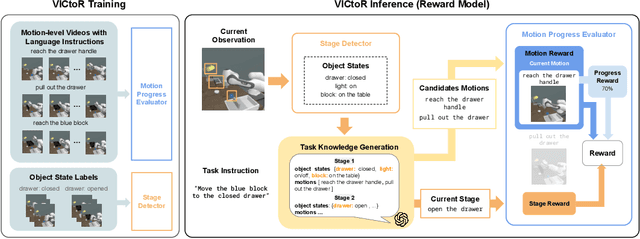

Abstract:We study reward models for long-horizon manipulation tasks by learning from action-free videos and language instructions, which we term the visual-instruction correlation (VIC) problem. Recent advancements in cross-modality modeling have highlighted the potential of reward modeling through visual and language correlations. However, existing VIC methods face challenges in learning rewards for long-horizon tasks due to their lack of sub-stage awareness, difficulty in modeling task complexities, and inadequate object state estimation. To address these challenges, we introduce VICtoR, a novel hierarchical VIC reward model capable of providing effective reward signals for long-horizon manipulation tasks. VICtoR precisely assesses task progress at various levels through a novel stage detector and motion progress evaluator, offering insightful guidance for agents learning the task effectively. To validate the effectiveness of VICtoR, we conducted extensive experiments in both simulated and real-world environments. The results suggest that VICtoR outperformed the best existing VIC methods, achieving a 43% improvement in success rates for long-horizon tasks.
AED: Adaptable Error Detection for Few-shot Imitation Policy
Feb 06, 2024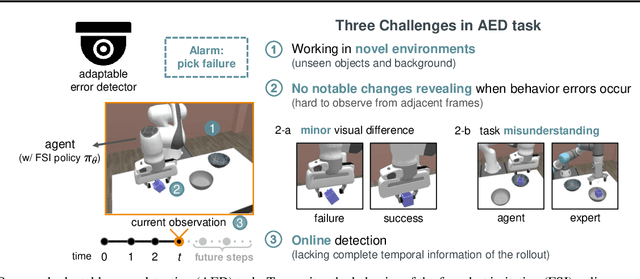
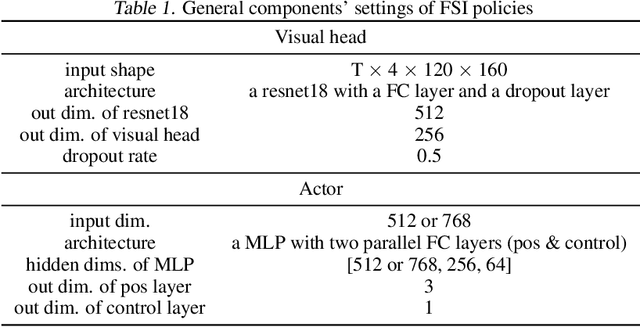
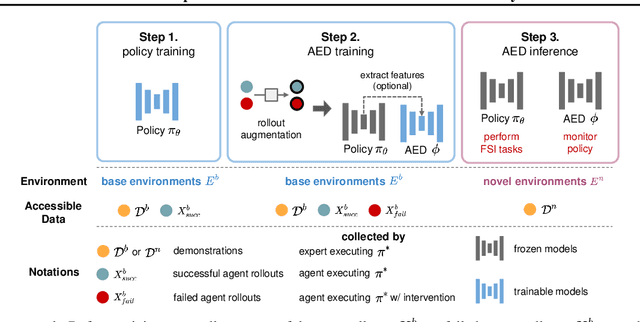
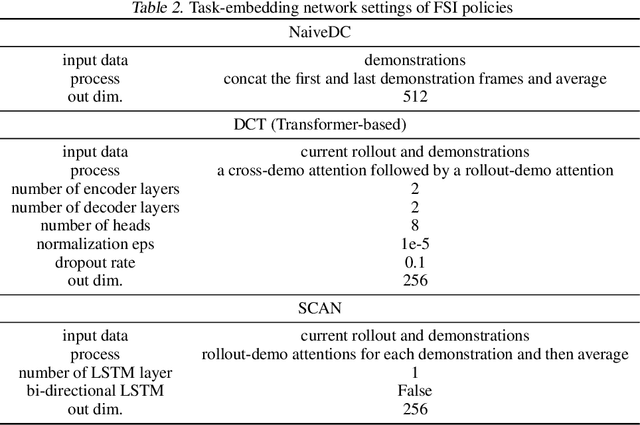
Abstract:We study how to report few-shot imitation (FSI) policies' behavior errors in novel environments, a novel task named adaptable error detection (AED). The potential to cause serious damage to surrounding areas limits the application of FSI policies in real-world scenarios. Thus, a robust system is necessary to notify operators when FSI policies are inconsistent with the intent of demonstrations. We develop a cross-domain benchmark for the challenging AED task, consisting of 329 base and 158 novel environments. This task introduces three challenges, including (1) detecting behavior errors in novel environments, (2) behavior errors occurring without revealing notable changes, and (3) lacking complete temporal information of the rollout due to the necessity of online detection. To address these challenges, we propose Pattern Observer (PrObe) to parse discernible patterns in the policy feature representations of normal or error states, whose effectiveness is verified in the proposed benchmark. Through our comprehensive evaluation, PrObe consistently surpasses strong baselines and demonstrates a robust capability to identify errors arising from a wide range of FSI policies. Moreover, we conduct comprehensive ablations and experiments (error correction, demonstration quality, etc.) to validate the practicality of our proposed task and methodology.
 Add to Chrome
Add to Chrome Add to Firefox
Add to Firefox Add to Edge
Add to Edge